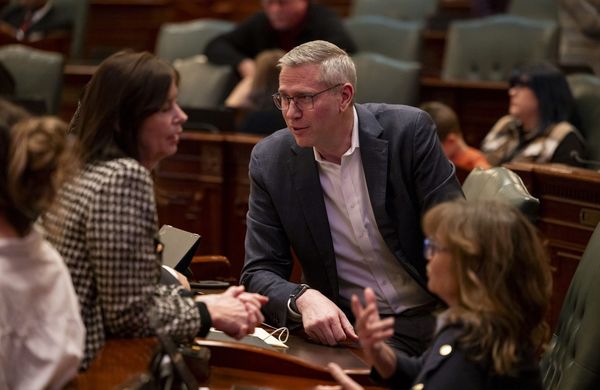
The Good Nurse is a film about a serial killer, but when Tobias Lindholm signed on to direct it, he and the screenwriter Krysty Wilson-Cairns removed any scenes that felt like they belonged in a typical serial-killer film. They excised the moments that showed the murderer, Charlie Cullen (played by Eddie Redmayne), returning to his sparse basement home. They deleted the sequence in which he nearly catches his fellow nurse Amy Loughren (Jessica Chastain) gathering evidence of his offenses. They didn’t force in any conventional thrills: high-octane car chases, close shaves with the police, flashbacks that attempted to explain Charlie’s motivations. When they finished, Lindholm told me over Zoom last month, “there were not that many scenes left.”
The effort was worth it, he explained, because he wanted The Good Nurse, now streaming on Netflix, to offer more than just spectacle and speculation. To him, true-crime film and TV have become “lost in the darkness,” producing “irresponsible storytelling” that leaves audiences “fascinated by cruel acts.” What was once a more somber approach to the consequences of killing—think In Cold Blood or documentaries such as The Thin Blue Line—has morphed, in the age of streaming, into a lowbrow guilty pleasure packed with Tiger Kings. In the mid-2010s, the podcast Serial, Netflix’s Making a Murderer, and HBO’s The Jinx became popular in part because audiences had migrated online, turning into amateur sleuths and dissecting the cases themselves. Hollywood indulged that appetite for mystery solving, pumping out projects that prioritize carnage over context.
Dawn Cecil, a criminology professor at the University of South Florida, points to Netflix’s Dahmer as the latest example. While researching her book Fear, Justice, and Modern True Crime, Cecil picked up on several patterns of how real-life nightmares get repackaged in popular culture: Most works involve female victims, gruesome reenactments, and a fascination with the assailants. The genre “is more sensationalized because it’s what the market is demanding,” she told me. “When it comes to these serial-killer stories, I don’t know if [hyperbole] is avoidable.”
Lindholm, The Good Nurse’s director, believes a different approach is possible. Charles Cullen was one of the most prolific American serial killers of all time. Over the course of his 16-year medical career, he tampered with IV bags, poisoning at least 29 victims and possibly hundreds more. But The Good Nurse, which is based on the book by Charles Graeber, refuses to indulge in those kills or explore Charlie’s psyche. Lindholm trains his lens instead on the culture that allowed Charlie to thrive—the fallible institutions meant to protect regular people, and the bystanders who didn’t intervene. The result is a film that’s no less chilling than other crime thrillers, but is far more illuminating about the human tragedy of cases like these.
The Good Nurse could’ve been structured like a police procedural, but that would have made Charlie the focus, and, Lindholm said, “we didn’t want to be fascinated with him.” The character of Amy Loughren proved to be the perfect entry point: She was a single mother of two and a health-care worker with a serious heart condition, forced to continue working because of her employer’s harsh requirements for insurance eligibility. The film shows how the pressure she was under made her vulnerable to Charlie’s deceptive kindness—and how evil manifests from the casual cruelty of both unfair systems and hardened criminals. It also shows how anyone can change the status quo. The filmmakers’ “responsibility is to find a light in there, a reason to enter the darkness,” Lindholm said. “For [us], Amy was that reason.”
The value of true crime has been subject to seemingly endless debate over whether such projects push audiences into tastelessly jockeying for clues and social-media engagement, and whether they turn victims into fodder for entertainment. The Good Nurse argues that the genre can depict evil without perpetuating its harms. Lindholm and Wilson-Cairns changed the names and circumstances of the portrayed victims to avoid re-traumatizing the actual families. The script builds tension by tracking Amy’s growing anxiety over whether her new friend, the quiet nurse so keen to cover shifts, could be a killer. Scenes of her conversations with Charlie, as a result, manage to be harrowing without involving a single drop of blood.
Perhaps the film’s most essential move is examining the health-care system with sympathy, not outright condemnation. A lesser film would treat a character like the fictionalized Linda Garran (Kim Dickens), the hospital’s risk manager, as a heartless suit representing the dispassionate administration. Her dialogue is certainly cold; in meetings with Amy and the investigators, she deflects, makes excuses, and doubles down on the institution’s faultlessness. But Lindholm worked with Dickens to ensure that the character’s growing doubt shined through her chilly exterior. “I told her, ‘Listen, I don’t want you to be the devil,’” he recalled. “‘You’re a human being who is caught in a system like the rest of us.’” Scene by scene, Linda becomes more and more aware of the consequences of her inaction. She’s not a tidy villain for audiences to root against. She feels more authentic because she grapples with her guilt.
In some ways, Linda serves as Amy’s foil. Both are trying to keep up with a system designed to make them work harder for less. But Amy decides to report Charlie’s red flags, risking both her standing in the hospital and her friendship with him—a connection she’d been relying on to cope with her health and family struggles. Linda sees those same red flags, but her instinct is to do the job she’s been assigned and wait for others to step up. To Lindholm, Linda’s role is to make audiences ask themselves, “When did I not help a fellow human in need?”
Few modern true-crime movies and shows remind viewers that they have as much responsibility over their own choices as the people onscreen do. That message may be uncomfortable to absorb, but it’s far more productive than luxuriating in disturbing acts. Watch enough murder mysteries, listen to enough podcasts, and the conclusions start blurring together. “Every true-crime narrative is the same,” Cecil pointed out. “When we think about [serial killers], there’s nothing else to learn about them.” But maybe, The Good Nurse suggests, there’s a lot left to learn about ourselves.







